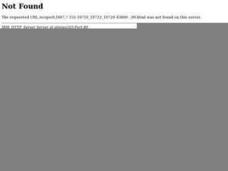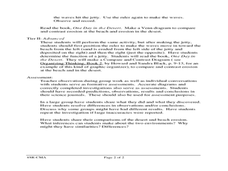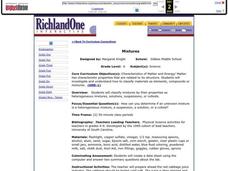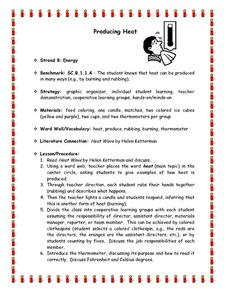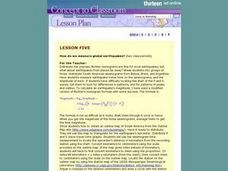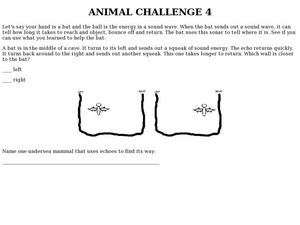Curated OER
What Shape Is It?
Young scholars predict the shape of an unknown object by bouncing a ball on it. In this physics lesson, students relate this activity to how dolphins use echo-location to navigate. They analyze their lab result and discuss findings.
Curated OER
Breaking News English: Indian Heat Wave Kills 200
In this English worksheet, students read "Sunbed Cancer Risk for Teens," and then respond to 47 fill in the blank, 7 short answer, 20 matching, and 8 true or false questions about the selection.
Curated OER
What's the Deal With Nature?
Twelfth graders read the poem "Crossing the Swamp" and "Pipefish" then discuss the use of metaphor in each poem. They write a poem about how they feel about school using a nature metaphor.
Curated OER
What's That Smell?
Students experiment with different scents (vanilla, peppermint, perfumes etc.) to explore their sense of smell.
Curated OER
Vibrations
Young scholars explore how vibrations create sound by strumming a rubber band. They feel the vibration of their own vocal chords. Then they explore the motion of sound waves and echoes. They rely on their own hearing to locate others in...
Curated OER
Beach Erosion Investigation
Learners determine the effects of gentle and strong waves on beach erosion. They use a stream table to simulate a beach and sketch the beach profile after simulated waves of different sizes.
Curated OER
Sea State
Students explain the process of wave formation and analyze the relationship between the ocean and the atmosphere. In this oceans lesson students use buoys to cast real time sea state conditions.
Curated OER
The Electron Microscope
In this microscope worksheet, students read about how the electron microscope was created and how it works. Based on the reading, students complete 2 short answer questions.
Curated OER
The Physical Environment
Fourth graders use damp sand, a baking pan, and water to simulate erosion. In this erosion lesson plan, 4th graders participate in a simulation to show what moving water does to land.
Curated OER
Are You My Mother Game
Students identify unknown sounds using their sense of hearing. They predict what objects were for the "Mother" game.
Curated OER
Mixtures
Sixth graders experiment with mixtures. In this chemistry lesson plan, 6th graders determine which mixtures are considered heterogeneous, a suspension, a solution or a colloid. Students create a data sheet of what they discover.
Curated OER
Fundamentals of Radio Communication
Twelfth graders explain the role of electromagnetic waves and antenna in radio communication. In this lesson, 12th graders examine circuit diagrams and solve wave related problems. They also calculate theoretical antenna...
Curated OER
Tune...Um!
Students collect real data on sound. In this algebra lesson plan, students use a CBL and graphing calculator to observe the graph created by sound waves. They draw conclusion about the frequency of sound from the graph.
Curated OER
Producing Heat
Students listen to "Heat Wave" by Helen Ketterman and discuss the story by creating a word web with heat as the main topic. They break into groups and conduct an experiment using a thermometer to record the temperature of melting ice...
Curated OER
How do we measure global earthquakes?
Students examine three seismograms of a recent South American earthquake recorded by USGS stations. They measure the S-P distance and use a P and S wave travel-time graph to find the epicenter distance for each seismogram. In addition,...
Curated OER
Homonyms and Homographs
In this homonym and homograph worksheet, students use a word bank to answer a set of 5 questions about homonyms, then do the same for 5 questions about homographs. An answer key is included.
Curated OER
Properties of the Ocean: Measurement
Students simulate the development of an underwater amusement park after reading background on Coral Reef State Park. They decide which factors they would need to consider such as the ocean floor, currents, wave patterns and water...
Curated OER
Contemporary Immigration
Eleventh graders analyze the patterns and waves of immigrants that have come to the United States from 1850 to 2000. They participate in a class discussion about immigration, and in small groups conduct research analyzing and evaluating...
Curated OER
Animal Challenge 4
In this sound energy worksheet, students predict what happens when bats bounce sounds off of walls to communicate. Students complete 2 questions.
Curated OER
Food Webs
Learners recognize interdependence in a food web by using yarn and notecards to create a food web and discussing what would happen if one of the organisms from a certain trophic level is removed.
Curated OER
Computer Software and ACS Materials for Chemistry
Young scholars use computer software to simulate chemistry laboratory experiments. In this experimenting using computer software lesson plan, students use software called "The One Computer Classroom" to investigate wave simulations as a...
Curated OER
Water and Ice
Pupils explore water. In this water lesson, students explore the physical properties and states of water. They observe how water changes states and document what they see.
Curated OER
Mathematical Models with Applications: The Sounds of Music
Students use an electronic data-collection device to model the sound produced by a guitar string. They identify the graph of a periodic situation and use the graph to determine the period and frequency of sound waves.




